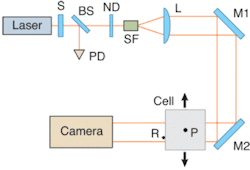A holographic technique intended for use in space has recently demonstrated the existence and behavior of a force called the history drag-a phenomenon predicted in 1887, but never before observed directly. The measurements were performed by researchers at MetroLaser (Irvine, CA) as part of a program called Spaceflight Holography Investigation in a Virtual Apparatus (SHIVA). Funded by the National Air and Space Administration (NASA), the research was intended to allow scientists on the ground to control and monitor microgravity experiments in space, thus reducing the number of people required to staff missions.
In a holographic setup for the SHIVA history-drag experiment, a 10-mW HeNe-laser beam is diffracted by particles (P) in an oscillating chamber, and the resulting patterns acquired for further processing by a 1-megapixel CCD camera. (S = shutter, BS = beamsplitter, PD = photodiode, ND = neutral density filter, SF = spatial filter, L = lens, M1 and M2 = mirrors, R = reference particle on face of oscillating cell.)
A hologram contains both phase and intensity information about an entire wavefront reflected from (or transmitted through) an object of interest. As such, it is the ideal way to transmit image information from an experiment without prejudging what may be important. With a high-quality holographic recording, a scientist can examine the object of interest by putting it under a microscope at different levels of magnification, or change angular perspective on it, all without the object actually being present. If a sequence of holograms is recorded, then incidents in time can be played, replayed, slowed down, and reversed. Itis as if the researcher is being provided with a window on the object in time and space-the Earth-bound scientist has a virtual laboratory in space.
The major drawback for most applications is that the amount of information in a hologram is much larger than conventional 2-D imaging techniques. The interference fringes that have to be recorded have features that extend down to a fraction of a wavelength of light, or tens of nanometres. For this reason, the resolution of holographic recording film is 10 to 100 times finer than that used for photography. This poses enormous problems when trying to record images for digital transmission-the large size and relatively small number of pixels in electronic cameras mean that holographic television (in the everyday sense of the word television) is impractical today.
However, according to SHIVA principal investigator James Trolinger of MetroLaser, electronic holography for scientific purposes is not so problematic, particularly when the object to be imaged is small. Instead of trying to acquire all the data in a single exposure, the experimenter can wait for it to be built up over time. This system that he and his colleagues have developed for use in space reduces the amount of information acquired still further by recording diffraction patterns and comparing them digitally, rather than creating an optical interference pattern between an object and reference wave (see figure).
History-drag experiments
Though SHIVA has yet to make it off the ground, it has already proved its worth as a scientific tool in recent history-drag experiments. The force that Trolinger and his colleagues were investigating was postulated by in1887 and applies to particles moving in an oscillating liquid (like the conditions at the bottom of the sea). Caused by a deformation of the molecules under the force of the opposing object, history drag slows down reaction of the liquid to relative motion.
In the late 1990s, Roger Rangel of the University of California at Irvine and Carlos Coimbra of the University of Hawaii-Manoa (Honolulu, HI) found the exact solution to the equations of motion relating to this phenomenon. It was unusual mathematically: rather than depending on the first or second derivative of the position with respect to time (like velocity or acceleration respectively), the history drag was proportional to the one-and-a-half derivative. Discovering whether this finding was borne out by the actual force behavior was one of the main goals of the experiment.
Trolinger, Rangel, and Coimbra designed a setup, intended to work in microgravity, to measure the effect. Among other issues, this involved building an oscillating chamber that would not, in turn, cause vibrations in the spacecraft that hosted it. They then decided to adapt SHIVA for use on the ground, simulating microgravity by attaching the particles of interest to optical fibers, thus reducing the effect of gravity on them. After compensating for the unwanted effects of these tethers, they were not only able to demonstrate that the history drag did indeed exist, but that it had the predicted one-and-a-half-derivative dependence.
The SHIVA concept was originally destined for use in the Space Station, but deployment there has now been suspended indefinitely because of the shift of focus caused by President George W. Bush’s “new vision for space exploration.” However, unlike many other programs, it has survived and is now being adapted for possible deployment on a Moon base or mission to Mars.
REFERENCE
1. C. F. M. Coimbra, et al., J. Fluid Mechanics 504, 353 (2004).
SUNNY BAINSis a scientist and journalist based at Imperial College, London; e-mail: [email protected]
About the Author
Sunny Bains
Contributing Editor
Sunny Bains is a contributing editor for Laser Focus World and a technical journalist based in London, England.

